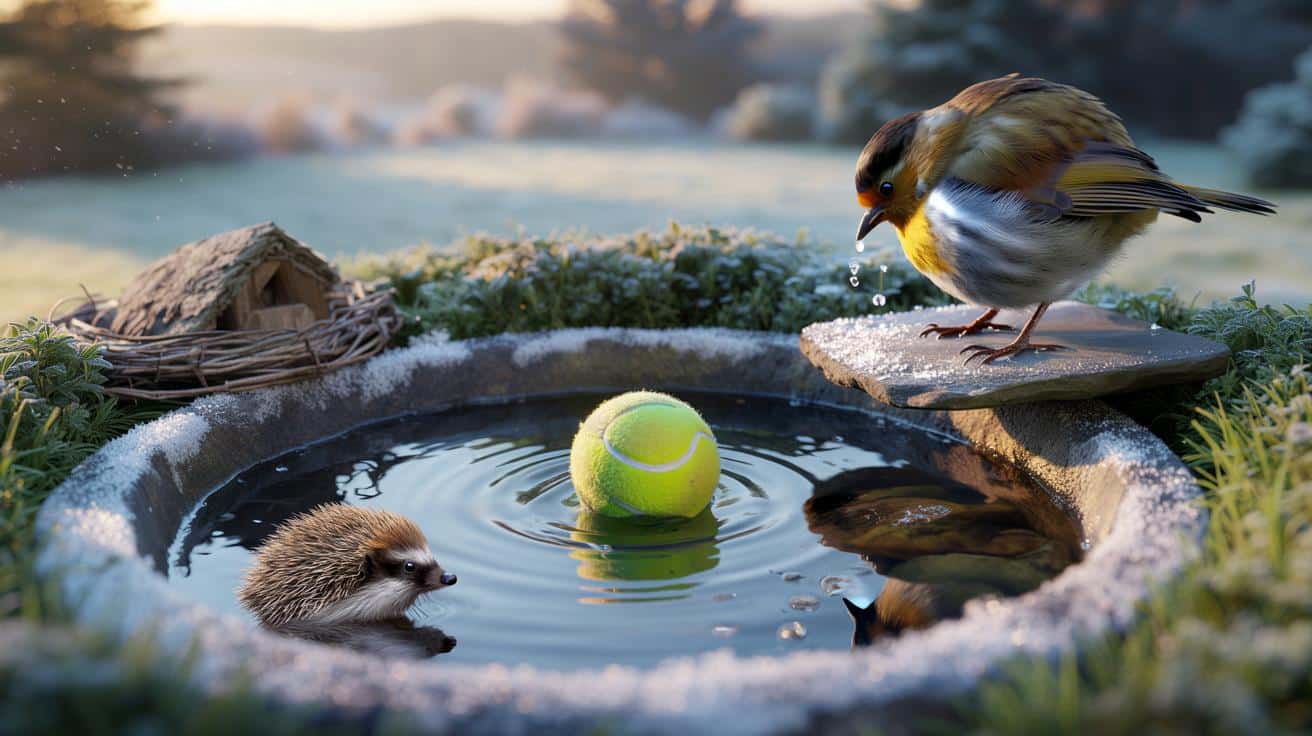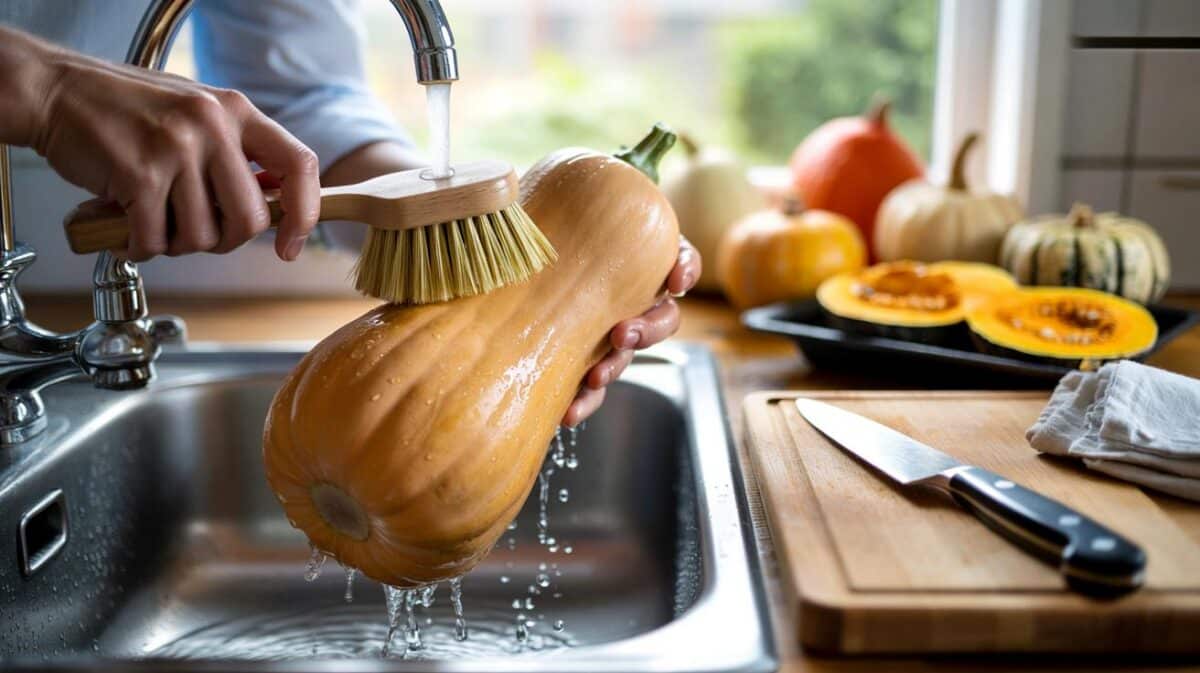Your garden choices matter more in winter.
A cheap, everyday object can keep fresh water available when temperatures drop, helping the creatures that share your patch. The fix takes less than a minute, works without power, and turns a small space into a lifeline during the longest nights.
Why a tennis ball beats the freeze
Place a tennis ball on the surface of a bird bath, tub, water butt or small pond. As wind and temperature shifts move the ball, it disrupts the ice forming across the surface. That constant nudge usually keeps a gap open, so birds, hedgehogs and small mammals can drink when they need it most.
Cold weather dehydrates wildlife quickly. Birds burn energy to stay warm and need water to preen and insulate their feathers. Hedgehogs wake on mild nights and seek safe sips before retreating again. A hand-sized opening in the ice often decides whether these visits end well.
One floating tennis ball can keep a drinkable gap open on small water features during light to moderate frost.
The ball also acts as a visual cue. Its bright colour marks a reliable station for hydration, especially near leaf piles, hedgehog houses or dense shrubbery where shy species shelter.
How to set it up in 30 seconds
- Choose a shallow container or a pond edge with easy access and an escape route.
- Float one tennis ball for small baths; use two for wider tubs or half barrels.
- Top up with clean water at dusk and again at first light during cold snaps.
- Place a flat stone or small ramp inside so any animal can climb out.
- Rinse the container weekly to prevent dirt and disease build-up.
Who benefits in your garden
Garden birds rely on open water to drink and to condition feathers for insulation and flight. Robins, blackbirds, wrens and tits show up first, often at dawn. Small mammals use safe, shallow access too. Hedgehogs need water after foraging for beetles and worms beneath leaf litter. Voles and shrews move discreetly along borders and take quick sips if the route feels safe from cats and foxes.
Amphibians hunker down but still use damp retreats. A nearby unfrozen source keeps microhabitats moist around logs, rocks and dense groundcover. That moisture supports invertebrates, which in turn feeds birds when the ground hardens.
Clean water supports more winter wildlife than extra feed alone, because hydration unlocks the energy animals already carry.
Small tweaks that multiply the effect
Pair the tennis ball with three simple upgrades and you support more species across longer cold spells.
- Leaf piles and deadwood stacks near the water encourage hedgehogs and invertebrates.
- Mixed hedges and dense shrubs cut wind chill and give low cover for small birds.
- Zero chemicals around water protects amphibians and insects that overwinter nearby.
Make it safe: avoid common pitfalls
Not every water feature helps. Steep sides trap tired animals. Deep tubs chill bodies fast. Cats learn routines. You can fix each risk with small adjustments that take minutes.
| Set-up | Risk in frost | Simple fix |
|---|---|---|
| Tall, deep bucket | Drowning or entrapment | Add a brick and a wooden ramp; keep water shallow |
| Smooth bird bath | Slippery edges | Place a flat stone for grip and safe perching |
| Open lawn site | Predator exposure | Move within 1–2 metres of dense cover |
| Stagnant water | Disease risk | Refresh daily during freezes; scrub weekly |
When the mercury plunges
Hard frost can seal surfaces despite movement. You can still keep a gap without gadgets. Pour in a jug of lukewarm water at first light. Never add salt or chemicals. Check the ramp sits just above the surface. On larger ponds, place two balls several feet apart to widen the moving zone and reduce full freeze-over.
In a -3°C night with calm air, two balls and a dawn top-up often maintain a usable gap until midday.
The simple physics behind the trick
Ice forms first on still water because crystals align more easily on a calm surface. A floating ball adds constant disturbance, so crystals struggle to create an unbroken sheet. Even when a skin appears, the ball’s movement breaks and enlarges it, preserving a small but vital pool.
Wind amplifies the effect by nudging both water and ball. The darker ball also absorbs a touch of winter sun, warming a thin halo of water at the edge. These tiny advantages buy crucial hours of access each day.
What to place where: a quick winter layout
Think like a visitor under pressure. Place one water point within a short dash of cover, another in a quiet corner for hedgehogs, and a third in open view for wary thrushes. Spread them so cats cannot patrol all sites at once.
- Near shrubs: a shallow dish on a crate, one tennis ball, leaf pile within arm’s reach.
- On patio: a heavy bird bath with a stone perch, one ball, no trailing cables or netting.
- By shed: a low tub with a ramp, two balls in colder spots, no slug pellets or weedkiller nearby.
Food, shelter and water work together
Seeds and fat help birds survive long nights, but hydration supports digestion and feather care. Shelters cut energy loss. Together, they reduce stress and keep animals active enough to seek natural forage when daylight returns.
Costs, time and what you gain
You can repurpose an old ball, a washing-up bowl and a spare brick. The time cost sits under five minutes on cold mornings. The gain arrives in the form of more regular visits, healthier birds, and hedgehogs that emerge in good condition when mild spells break the freeze.
Households in the same street can multiply the effect. Two or three gardens with safe water points create a mini network, so animals avoid risky crossings and still find a drink within a short range.
Extra tips for stronger results
Swap cracked tennis balls for new ones if water soaks in and they sink. Choose shallow, wide containers over deep, narrow ones. If you keep fish, place the ball away from a pump outflow so both actions complement rather than cancel. In exposed plots, a low windbreak of twigs around the bath reduces chill and helps the ball move just enough.
Run a simple check each evening. If ice sealed over despite the ball, widen the opening by hand, reset the ramp and add a second ball. On very still, very cold nights, a small bundle of twigs laid across the surface breaks sheets and gives perches without trapping wildlife.








